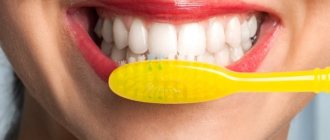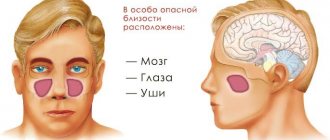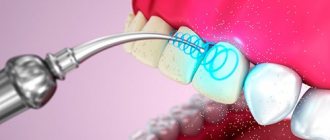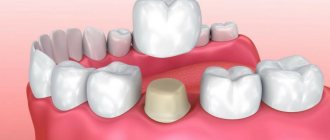Causes of pain under the crown
To cope with the unpleasant symptom of pain under the crown, you need to establish the exact cause. This can be done quickly and reliably by a doctor after an external examination and radiography. You can also independently understand why tooth pain appears at a certain period of life, and with this guess, consult a doctor.
The most likely cause of this symptom will be inflammation of the pulp, but this is only possible if the tooth was not pulpless before prosthetics. If the nerve bundle has been removed, pain may be a consequence of secondary caries or allergies. Less commonly, the causes are gum chafing or periodontitis.
All possible reasons why a tooth hurts under the crown:
- infection of the root canal when the doctor leaves an instrument in it;
- damage to the root walls due to poor preliminary preparation;
- excessive filling of the canal with filling material;
- aggravated periodontitis (when there is pus in the root canal);
- presence of untreated caries;
- improper oral care after crown installation;
- wear and tear of the artificial tooth.
The period of onset of pain will help to understand the cause: if it bothers you in the first days after the installation of the crown and manifests itself acutely, this may be due to improper preparation of the tooth. Late pain often indicates chronic processes that have worsened.
Causes
Pain in the gums under the crown indicates the development of an inflammatory process. The reasons for this can be divided into several groups.
Crown injuries
During tooth preparation, the orthopedist forms a kind of “step” so that the artificial structure does not put pressure on the gingival margin. However, in some cases this cannot be achieved, then the crown begins to put pressure on the gums, causing circulatory problems.
If the edges of the crown overhang, it will exert a mechanical force on the edge of the gum. This leads to microtraumas and damage to the integrity of the mucosa. Quite quickly, inflammatory processes begin to develop in these places. To avoid this situation, orthopedic dentists try to install the structure end-to-end rather than overlapping.
However, opposite situations also occur when the crown does not go beyond the gum, but, on the contrary, does not reach it. In this case, food and saliva accumulate in the space left empty. Sooner or later, this also leads to the development of an inflammatory process, even with good hygiene.
Poor preparation for prosthetics
Poor preparation for prosthetics is the most common cause of complications.
Poor preparation refers to the poor quality of the doctor’s work and the mistakes he makes. Among them the most common:
- Trauma to the gums during tooth preparation. When the doctor grinds away dental tissue to install a prosthesis, the gum may be touched with a diamond bur. An instrument rotating at high speed (400 rpm) plucks out pieces of gum tissue, which subsequently leads to inflammation.
- Poor filling of root canals. In most cases, teeth are depulped before prosthetics. The final stage of depulpation is root canal filling, which is carried out under X-ray control. If the filling does not reach the root tip, voids are formed in which bacteria begin to multiply. For this to happen, it is enough to leave only 1-2 mm without a filling.
- Perforation of the root canal, which can occur during treatment or when fixing the pin. Such mistakes also often cause inflammation that spreads to the gums.
- Breaking off an instrument is a mistake that is made not only by beginners, but sometimes by experienced doctors. There are requirements for the use of tools that are used to process canals (for example, many of them are prohibited from being rotated more than 120 degrees). If the doctor does not comply with these requirements, the thin instruments may break, leaving a foreign body in the canal.
Associated symptoms
In addition to pain, possible diseases that occur in the tooth under a microprosthesis give other symptoms. Their character also helps to determine the cause and select treatment. Most often, the gums begin to bleed, and pus accumulates under the microprosthesis.
What other manifestations may bother you along with pain under the crown:
- loosening of the tooth;
- redness of the gums, the appearance of gumboil;
- bad breath due to the discharge of pus;
- increased gum sensitivity;
- increased pain when pressing on the causative tooth;
- bleeding when brushing teeth;
- itching, swelling of the gums, plaque.
When the cause is inflammation of the pulp, the pain will be acute and appear mainly in the evening and at night. If the pain is caused by caries, there will be an increased reaction to cold and hot, and there will also be bad breath and it will be painful to chew.
With periodontitis, unpleasant sensations will occur near the neck of the tooth, and then there are also signs of inflammation (redness, swelling). When the provocateur is the incorrect installation of the crown, then it will become loose, put pressure on the soft tissues, and rub them. With any pathology, the gums near the crown can become inflamed, but this will not always be the main cause of pain.
Preventive measures
It is important to remember that every specialist who installs crowns and dentures should tell you everything about oral hygiene and preventive measures.
It is necessary to follow all recommendations and advice prescribed by a specialist:
- Brushing your teeth twice a day;
- Thorough cleaning of food debris from interdental crevices and hard-to-reach places;
- Eat less sweet, hard and sticky foods;
- Periodic visits to a specialist to examine the oral cavity;
- It is better to cool a very hot dish or drink slightly or wait a while so as not to injure the roots of the teeth and the enamel in general.
First aid
If a toothache occurs, you should not endure it. Both medications and some folk remedies are suitable for providing first aid. It is only important to remember that pain relief is not a curative measure, and after providing first aid you should immediately contact a dentist.
Ways to relieve pain when a tooth hurts under the crown: what to do for quick help:
- Take a pain reliever. This may be an analgesic or a non-steroidal anti-inflammatory drug. The main drugs prescribed by a doctor to relieve toothache are Nimesil, Ketanov, Nise, Diclofenac, Ibuprofen.
- Rinse your mouth with soda solution or herbal decoction. For this purpose, you can use sage, chamomile, and oak bark. It is important to rinse several times and use only warm water.
- Apply a cold compress to your cheek.
It is important to understand that frequent use of pain medications may affect your sensitivity to anesthesia during dental treatment. If you have to undergo painful procedures at a doctor's appointment, the painkiller may not be fully effective.
If a tooth reacts sharply to cold or hot, what could be the problem?
If the tooth under the crown begins to react to hot and cold food, what is the problem?
It’s understandable that it’s time to go to the dentist, but I’d like to hear your opinion, I’m sure someone else has had the same experience.
What did you do about this problem?
You can put a new crown, you can build it up, you can put metal ceramics.
What did you do in a similar situation?
The tooth is the third bottom, the crown is coated metal.
It costs about 12 years. — 6 years ago
I think the problem is that there is a small ulcer in the tooth, heat and cold pass through it, or the nerve in the tooth is too close to the enamel, but most likely the first
In the adjacent tooth, on the side of the crown, there was a channel where heat and cold entered.
I went to the doctor, they put a filling in, removed the crown, there is also a small problem there, I will replace the old gold-plated metal ceramics.
Uuuu.. 12 years.. well, her time has come. Nothing is eternal.
The dentist explained to my mother something, I don’t remember what - she also had... She had crowns for 15 years... they were apparently worn out in places, something began to get under them, rot, become inflamed... in general, it’s urgent to remove these tin cans and put in new ones .
And metal-ceramics simply looks more aesthetically pleasing, the tooth is noticeable... It will look like an ordinary tooth. Well, of course, look at the prices for yourself. In our city, metal ceramics are now 4.5 thousand per tooth. It’s just that ceramics are even more expensive – about 10 thousand. I don’t see the point in it.
The dentist will open the crown and look at what you have there - it doesn’t cost a lot of money, and then put it in, you can safely walk without the crown for a while - there’s nothing wrong with it. And if you don't open it, it could be worse...
Just go for a consultation first.











